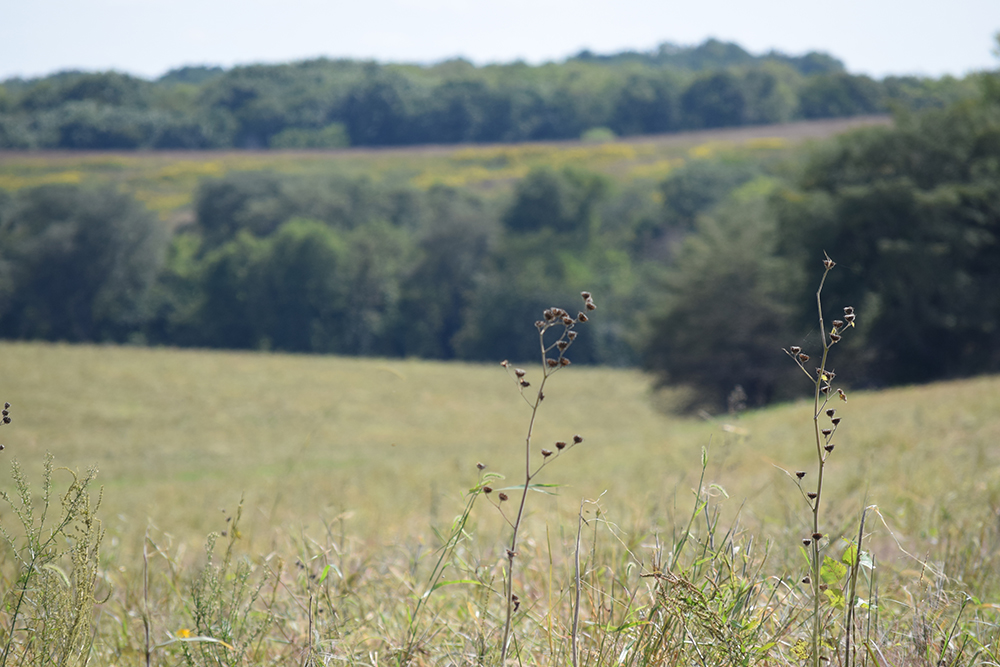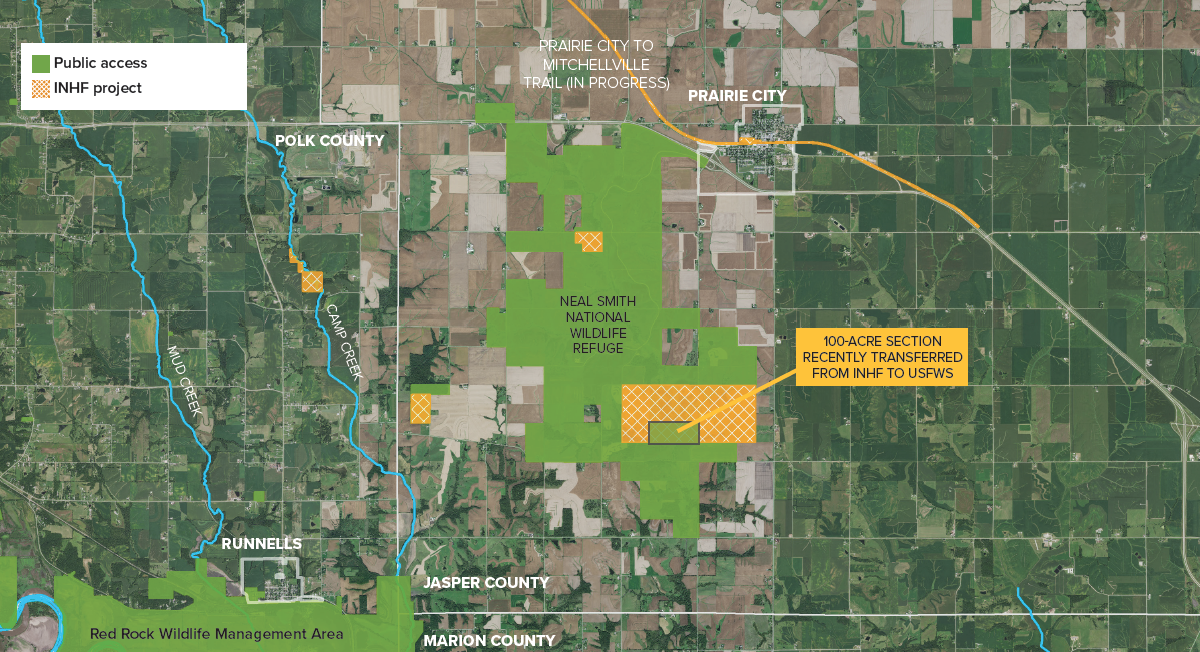INHF helping expand Neal Smith National Wildlife Refuge
By Joe Jayjack on December 27, 2016 in Blog
Some Central Iowans would never guess that less than half an hour from their door, an opportunity to step back in time awaits.
Travel east along Highway 163, and you’re transported to a landscape wildlife and humans traversed centuries ago. The windblown prairies, oak savannas and herds of bison and elk at the Neal Smith National Wildlife Refuge are a snapshot of pre-European settlement Iowa — a look back at the state’s natural heritage.
 The refuge sits in the southwest corner of Jasper County near Prairie City, just a few miles north of the Des Moines River valley. The diverse tallgrass prairie stands in contrast to working landscape around the refuge. The site is home to hundreds of native plant species, more than 200 bird species and dozens of mammals, reptiles, amphibians and butterflies.
The refuge sits in the southwest corner of Jasper County near Prairie City, just a few miles north of the Des Moines River valley. The diverse tallgrass prairie stands in contrast to working landscape around the refuge. The site is home to hundreds of native plant species, more than 200 bird species and dozens of mammals, reptiles, amphibians and butterflies.
The refuge hasn’t always looked like this. For more than a century, most of the land that now makes up the refuge was working land — cropland and pastures that are so familiar to Iowans today. Following the energy crisis in the 1970s, Iowa Power and Light Company (now known as MidAmerican Energy) purchased much of this farmland with the intention of building a nuclear power plant. When that plan was scrapped in the late 1980s, U.S. Congressman Neal Smith saw an opportunity.
Smith championed the effort to create an expansive natural sanctuary, and an act of Congress created the Walnut Creek National Wildlife Refuge in 1990. It was renamed in honor of Smith in 1998, and is one of only six national wildlife refuges in the state. The mission of Neal Smith National Wildlife Refuge is to actively protect, restore, reconstruct and manage the diverse native ecosystems of tallgrass prairie, oak savanna and sedge meadow, the native habitats existing in Iowa before Euro-American settlement.
The refuge’s scale is truly impressive: its nearly 5,600 acres is the largest tallgrass prairie ecosystem reconstruction in the world. It’s an ongoing experiment in the protection and restoration of native plants and animals to Iowa’s landscape.
The refuge staff is also an education source for landowners hoping to improve natural areas and wildlife habitat of their own property.
Partnership for expansion
And the refuge continues to grow. The U.S. Fish and Wildlife Service (USFWS), which manages the refuge, is authorized to expand the size of the refuge up to 8,665 acres inside the Walnut Creek watershed, by purchasing land from willing landowners. More opportunities to add to the refuge are presenting themselves.
But federal funding isn’t always available when land inside the refuge’s expansion boundary comes up for sale. That is where Iowa Natural Heritage Foundation and the Friends of Neal Smith National Wildlife Refuge come in.
 In 2008, INHF bought 840 acres from a private landowner near the south end of the refuge. The rectangular piece was surrounded on three sides by refuge land and includes a section of Walnut Creek. The property is vital for connecting the refuge’s wildlife habitat and protecting the creek’s watershed. But at the time of purchase, there was no clear funding plan for a transfer to USFWS. Because of this uncertainty, the Friends of Neal Smith National Wildlife Refuge provided over half the financial assistance that allowed INHF to hold the property long-term. A large bequest to INHF at the time also helped.
In 2008, INHF bought 840 acres from a private landowner near the south end of the refuge. The rectangular piece was surrounded on three sides by refuge land and includes a section of Walnut Creek. The property is vital for connecting the refuge’s wildlife habitat and protecting the creek’s watershed. But at the time of purchase, there was no clear funding plan for a transfer to USFWS. Because of this uncertainty, the Friends of Neal Smith National Wildlife Refuge provided over half the financial assistance that allowed INHF to hold the property long-term. A large bequest to INHF at the time also helped.
“We took that chance together, not knowing how it would play out, but we knew protecting this area was important,” INHF President Joe McGovern said.
Earlier this year, the first 100 acres of this piece transferred to the refuge. It was the first land addition to the refuge in almost a decade. Another 230 acres will be transferring soon.
“We’re hoping this can inspire more protection around the refuge,” said Ross Baxter, INHF land projects director. “And in the meantime, INHF has been able to work on restoring pieces that will eventually be part of the Neal Smith Wildlife Refuge.”
In 2015, INHF purchased another 47 acres near the north end of the refuge, adjacent to the bison and elk pen. The Friends of Neal Smith group, a private nonprofit whose goal is to support the refuge mission through volunteering and fundraising, has been vital in making these projects happen. They have provided financial backing to the projects while advocating to local landowners and donors for expanded protection around the refuge.
“From the beginning, we’ve seen this as a partnership. We all want to make the refuge an even better place,” McGovern said.
The refuge, the friends group and INHF all have the protection and restoration of Iowa’s natural landscape — and helping people make a connection to those natural areas — at the core of their mission. There are few places in Iowa where it can be done at this scale.

A truly urban refuge
Tallgrass prairie, which used to cover more than 28 million acres in Iowa, is an endangered ecosystem. Less than 0.1 percent of that original tallgrass prairie landscape remains in the state.
 But few people know just how close this massive restoration effort is to Iowa’s largest metro. Visitors can get from downtown Des Moines to the middle of a roaming bison herd in 30 minutes.
But few people know just how close this massive restoration effort is to Iowa’s largest metro. Visitors can get from downtown Des Moines to the middle of a roaming bison herd in 30 minutes.
The refuge has embraced its urban status: its programs and staff are focused on introducing Iowans to their once-native landscape and getting people to find, appreciate and care for nature in their community. The Prairie Learning Center hosts educational events, including school field trips, year-round. Newly installed bike lanes along the entrance road to the refuge embraces Iowa’s growing cycling community and connects those on two wheels to Prairie City, and eventually the larger central Iowa trail system (see page 15). And the hiking trails around the refuge allow people to see the native ecosystems at ground level, discovering the diverse plant, bird and insect life that call the refuge home.
An elk finding the shade of a massive Cottonwood tree has a timeless feeling. When you see the baby bison frolicking through the prairie in the spring, the migrating monarchs finding milkweed in the summer or the fields of yellow flowers covering the hillsides in the fall, it’s easy to be transported to another era.
It’s hard to imagine this area without the refuge.
But that makes this partnership — between INHF, the USFWS, the friends group and the surrounding community — that much more important.